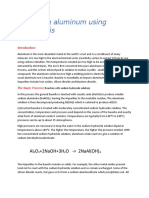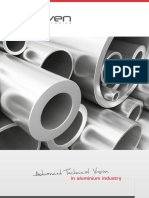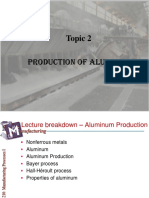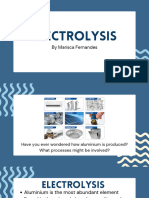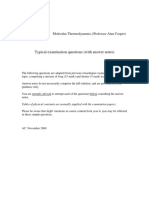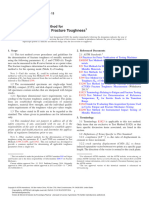0 ratings0% found this document useful (0 votes)
9 viewsExtraction of Aluminium
Extraction of Aluminium
Uploaded by
chkim26Aluminium is extracted through electrolysis of alumina in a Hall-Héroult cell. Bauxite ore is purified to produce alumina, which is mixed with cryolite to lower its melting point for electrolysis. During electrolysis, alumina ions are reduced to aluminium at the cathode, and oxygen is produced at the anode, where it reacts with carbon from the anode to form carbon dioxide. The molten aluminium sinks to the bottom of the tank.
Copyright:
© All Rights Reserved
Available Formats
Download as PDF, TXT or read online from Scribd
Extraction of Aluminium
Extraction of Aluminium
Uploaded by
chkim260 ratings0% found this document useful (0 votes)
9 views1 pageAluminium is extracted through electrolysis of alumina in a Hall-Héroult cell. Bauxite ore is purified to produce alumina, which is mixed with cryolite to lower its melting point for electrolysis. During electrolysis, alumina ions are reduced to aluminium at the cathode, and oxygen is produced at the anode, where it reacts with carbon from the anode to form carbon dioxide. The molten aluminium sinks to the bottom of the tank.
Copyright
© © All Rights Reserved
Available Formats
PDF, TXT or read online from Scribd
Share this document
Did you find this document useful?
Is this content inappropriate?
Aluminium is extracted through electrolysis of alumina in a Hall-Héroult cell. Bauxite ore is purified to produce alumina, which is mixed with cryolite to lower its melting point for electrolysis. During electrolysis, alumina ions are reduced to aluminium at the cathode, and oxygen is produced at the anode, where it reacts with carbon from the anode to form carbon dioxide. The molten aluminium sinks to the bottom of the tank.
Copyright:
© All Rights Reserved
Available Formats
Download as PDF, TXT or read online from Scribd
Download as pdf or txt
0 ratings0% found this document useful (0 votes)
9 views1 pageExtraction of Aluminium
Extraction of Aluminium
Uploaded by
chkim26Aluminium is extracted through electrolysis of alumina in a Hall-Héroult cell. Bauxite ore is purified to produce alumina, which is mixed with cryolite to lower its melting point for electrolysis. During electrolysis, alumina ions are reduced to aluminium at the cathode, and oxygen is produced at the anode, where it reacts with carbon from the anode to form carbon dioxide. The molten aluminium sinks to the bottom of the tank.
Copyright:
© All Rights Reserved
Available Formats
Download as PDF, TXT or read online from Scribd
Download as pdf or txt
You are on page 1of 1
EXTRACTION OF
ALUMINIUM
Aluminium is extracted by electrolysis, commonly from bauxite ore using the Hall-
Heroult process
Bauxite Ore Alumina
Alumina is mixed with calcium
Bauxite ore is a mixture fluoride or cryolite to lower its
of hydrated aluminium high melting point of around
oxide that contains 2,000 degrees celsius to 900-
950 degrees celsius. Cryolite
ferric oxide and silica,
also acts as a solvent which
which are impurities.
melts the alumina to increase
Therefore, as part of the its conductivity. This reduces
extraction process, the energy cost of the
bauxite is purified to extraction, as the ions can still
produce Alumina. move freely at low
temperatures.
Reactions at the Reactions at the
Cathode Anode
2Al2O3 + 3C → 4Al + 3CO2
At the anode: Oxide ions are oxidised to form
oxygen molecules. (2O2– →O2 + 4e–)
At the cathode: aluminium ions receive The oxygen molecules from the aluminium
electrons and are reduced to atoms. oxide react with the carbon from the graphite
(Al3+ + 3e– → Al) anode and forms carbon dioxide. As this is a
The aluminium, now in a molten state, sinks to combustion reaction, the anodes gradually burn
the bottom of the tank as it is heavier than the away, and therefore need to be replaced
cryolite solution. regularly.
→
(C (s) + 2O2- CO2 (g) + 4e–)
You might also like
- Bett Process 2Document14 pagesBett Process 2Ade SatriaNo ratings yet
- S.6 Chemistry of Aluminium, Group IV Group VIIDocument78 pagesS.6 Chemistry of Aluminium, Group IV Group VIIABEL JEDIDIAHNo ratings yet
- Aluminium SmeltingDocument41 pagesAluminium SmeltingVanamali Krish100% (1)
- Extraction of AluminiumDocument5 pagesExtraction of AluminiumJojo HanyNo ratings yet
- Al ExtractionDocument27 pagesAl Extractionbt19108055 Amarjeet KumarNo ratings yet
- Chem 17 - PRODUCTION OF ALUMINUM BY HALL-HĔROULT PROCESSDocument3 pagesChem 17 - PRODUCTION OF ALUMINUM BY HALL-HĔROULT PROCESSWilfredo LlanaNo ratings yet
- CH16 - Extraction & Corrosion of MetalsDocument6 pagesCH16 - Extraction & Corrosion of Metalsbriscelyn.f.cNo ratings yet
- Unit-6 BoronDocument22 pagesUnit-6 BoronSanjay KumarNo ratings yet
- Extracting AluminiumDocument6 pagesExtracting Aluminiumkparqs10No ratings yet
- Aluminium ExtractionDocument1 pageAluminium Extractionzainab.fatima1150No ratings yet
- Extractive Metallurgy 3Document5 pagesExtractive Metallurgy 3naitikdhanotiya3No ratings yet
- Extracting Aluminum Using ElectrolysisDocument4 pagesExtracting Aluminum Using ElectrolysisSaed ELkelanyNo ratings yet
- Extracting Aluminum Using ElectrolysisDocument4 pagesExtracting Aluminum Using ElectrolysisSaed ELkelanyNo ratings yet
- SeminarDocument24 pagesSeminarLalit GuptaNo ratings yet
- NON-FERROUS Extractive FinalDocument40 pagesNON-FERROUS Extractive FinalJaidevNo ratings yet
- Extraction of Metals - MockDocument19 pagesExtraction of Metals - MockPuraniNo ratings yet
- Extraction of AluminiumDocument12 pagesExtraction of Aluminiumsheelamourya12088No ratings yet
- Technical English II For CMA and GMDocument34 pagesTechnical English II For CMA and GMChk WalkerNo ratings yet
- Extraction of AluminiumDocument1 pageExtraction of AluminiumNaditaNo ratings yet
- IndustrialchemistryDocument2 pagesIndustrialchemistryKimtuyen TranNo ratings yet
- Chapter 15 - Extraction and Uses of Metals (PC 07.11.2023)Document8 pagesChapter 15 - Extraction and Uses of Metals (PC 07.11.2023)Peter CahillNo ratings yet
- WEEK11 AlDocument7 pagesWEEK11 Alhussamjamal432No ratings yet
- Presentation AluminiumDocument15 pagesPresentation AluminiumsreelakshmioduvilNo ratings yet
- The Extraction of Metals: Mr. AgachaDocument9 pagesThe Extraction of Metals: Mr. AgachaMasaria LowlandNo ratings yet
- AluminiuDocument10 pagesAluminiuioan_vNo ratings yet
- Metal Extrctn. Notes: Ores: Haematite FeDocument4 pagesMetal Extrctn. Notes: Ores: Haematite FeAlex noslen100% (1)
- Inorganic Chemistry: Group 13 AluminiumDocument38 pagesInorganic Chemistry: Group 13 AluminiumLooi Chui Yean0% (1)
- Extraction of Alumina From Bauxite ResidueDocument10 pagesExtraction of Alumina From Bauxite ResidueDennis KusumaNo ratings yet
- Seven Refractories Aluminio PDFDocument15 pagesSeven Refractories Aluminio PDFjose.figueroa@foseco.comNo ratings yet
- Chemistry With Boos Chapter 1.5, 4.1 and 4.2Document1 pageChemistry With Boos Chapter 1.5, 4.1 and 4.2jos huaNo ratings yet
- Chapter 5 Group 13 ElementsDocument16 pagesChapter 5 Group 13 ElementsSyxfiqxh NjwaNo ratings yet
- Week 10 ExctMet-AlDocument37 pagesWeek 10 ExctMet-AlYudha PradhanaNo ratings yet
- Bayer ProcessDocument2 pagesBayer ProcessTriono SyakbaniNo ratings yet
- Metallurgy of AluminiumDocument9 pagesMetallurgy of Aluminiumhassan materialsNo ratings yet
- ElectrochemistryDocument2 pagesElectrochemistryfiqaNo ratings yet
- CAPE Chemistry Unit 2Document22 pagesCAPE Chemistry Unit 2Audi SweetangelNo ratings yet
- Metal ExtractionDocument54 pagesMetal ExtractionShravani KanojiaNo ratings yet
- High Purity AluminaDocument13 pagesHigh Purity AluminaNilay JoshiNo ratings yet
- Metals KS3 4 Iron and Aluminium Extraction Methods Info SheetDocument5 pagesMetals KS3 4 Iron and Aluminium Extraction Methods Info SheetHappy NthakomwaNo ratings yet
- Application Note AluminiumDocument6 pagesApplication Note Aluminiumjose_ruben_64No ratings yet
- Metallographic Preparation of Aluminium and Aluminium AlloysDocument6 pagesMetallographic Preparation of Aluminium and Aluminium AlloysSergioNo ratings yet
- Application Note AluminiumDocument6 pagesApplication Note AluminiumJosé Victor Quispe CuyaNo ratings yet
- METEXPPDocument50 pagesMETEXPPMaryamNo ratings yet
- Al, Groups (IV) and (VII) June 2016.Document58 pagesAl, Groups (IV) and (VII) June 2016.florencenamukasa11No ratings yet
- 02 - Production of AluminumDocument33 pages02 - Production of AluminumblackgohstNo ratings yet
- Purification of CopperDocument12 pagesPurification of CopperAlrazi ArmanNo ratings yet
- The Extration of The Versitile AluminiumDocument36 pagesThe Extration of The Versitile Aluminiumvishnu_c_singhNo ratings yet
- The Making Alumunium Review Alumunium Is Active MetalDocument2 pagesThe Making Alumunium Review Alumunium Is Active MetalFikan Mubarok RohimsyahNo ratings yet
- Native Specimens: Alfian Pangestu 2712100041 The Making AluminiumDocument2 pagesNative Specimens: Alfian Pangestu 2712100041 The Making AluminiumAli YafiNo ratings yet
- Extraction of Aluminum From Ore OxideDocument9 pagesExtraction of Aluminum From Ore OxideAbdullah MohsinNo ratings yet
- ElectrolysisDocument13 pagesElectrolysisshaan.chauhan97No ratings yet
- Chapter14 StudentDocument18 pagesChapter14 Studentp98sc5qw5dNo ratings yet
- Extractive Metallurgy Final Term NotesDocument19 pagesExtractive Metallurgy Final Term NotesWajid RaheemNo ratings yet
- AluminiumDocument32 pagesAluminiumNanda Rizky50% (2)
- Aluminium MetallurgyDocument3 pagesAluminium MetallurgyShubham ShuklaNo ratings yet
- Synthetic Rutile PDFDocument3 pagesSynthetic Rutile PDFrazor75apNo ratings yet
- Application Notes Copper EnglishDocument6 pagesApplication Notes Copper EnglishAristides ChaconNo ratings yet
- Hall Heroult Process and Hooper ProcessDocument9 pagesHall Heroult Process and Hooper ProcesssaadNo ratings yet
- Luminum: Properties, Uses, Extraction Process, Aluminum AlloysDocument36 pagesLuminum: Properties, Uses, Extraction Process, Aluminum AlloysismaeelNo ratings yet
- Tropical ClimatesDocument15 pagesTropical ClimatesKeshavSeeamNo ratings yet
- Module 8 Newtons Law of Cooling 3Document17 pagesModule 8 Newtons Law of Cooling 3wman07469No ratings yet
- Wave Particle DualityDocument7 pagesWave Particle DualityRahmatullahNo ratings yet
- Coulomb BlockadeDocument22 pagesCoulomb BlockadeAmanjit SinghNo ratings yet
- 8 D For ShrinkageDocument6 pages8 D For ShrinkageSachin KumbharNo ratings yet
- Tugas 1 FistanDocument2 pagesTugas 1 FistanMohammed AspharNo ratings yet
- Typical Examination Questions (With Answer Notes) : Chemistry-2X: Molecular Thermodynamics (Professor Alan Cooper)Document8 pagesTypical Examination Questions (With Answer Notes) : Chemistry-2X: Molecular Thermodynamics (Professor Alan Cooper)ERIKO DARMAWAN100% (1)
- VIDEO SCRIPTWRITING TEMPLATE With CONTENTDocument13 pagesVIDEO SCRIPTWRITING TEMPLATE With CONTENTMary Jane Banguel GuiyabNo ratings yet
- MaterialDocument84 pagesMaterialSelva RajuNo ratings yet
- Boiler-Turbine Operation Start Up ExplainedDocument35 pagesBoiler-Turbine Operation Start Up ExplainedSteven100% (1)
- Astm E1820 13 k1c j1c CtodDocument54 pagesAstm E1820 13 k1c j1c CtodraphaelmecanicaNo ratings yet
- Drude Model-WikipediaDocument6 pagesDrude Model-WikipediaGabriel0% (1)
- Solsperse W400 in Nano Dispersion For BTVNDocument17 pagesSolsperse W400 in Nano Dispersion For BTVNhai nam hoNo ratings yet
- Chapter 5 DC Circuit-2Document28 pagesChapter 5 DC Circuit-2MASYITAH MOHD PADZILNo ratings yet
- MARIO (CADAM 2000 - Model Parameters)Document4 pagesMARIO (CADAM 2000 - Model Parameters)Jorge ManhepeNo ratings yet
- Acoustic Monopoles Dipoles and Quadrupoles An ExpeDocument6 pagesAcoustic Monopoles Dipoles and Quadrupoles An ExpeDokumentasi FPA XVINo ratings yet
- GuideDocument770 pagesGuidepavankumar001No ratings yet
- Torsional Vibration RotorDocument59 pagesTorsional Vibration Rotordaongocha108100% (1)
- Reservoir Analysis SystemDocument24 pagesReservoir Analysis SystemCosmin Ducea100% (1)
- 03-AHU Schedule 16-02-11Document23 pages03-AHU Schedule 16-02-11karunvandnaNo ratings yet
- gf2 gf3 ps10097 enDocument8 pagesgf2 gf3 ps10097 enOmar JarwanNo ratings yet
- GRC SlabDocument10 pagesGRC SlabWayne KentNo ratings yet
- Subject: Petroleum Geoscience Student: Elvin Hajiyev Topic: Significance and Origin of CarbonateDocument9 pagesSubject: Petroleum Geoscience Student: Elvin Hajiyev Topic: Significance and Origin of CarbonateElvin HajiyevNo ratings yet
- CHEMISTRY INVESTIGATORY PROJECT Class 12Document17 pagesCHEMISTRY INVESTIGATORY PROJECT Class 12Cinin . SNo ratings yet
- Fluid Mechanics Applied To Medicine Cardiac Flow Visualization TechniquesDocument97 pagesFluid Mechanics Applied To Medicine Cardiac Flow Visualization TechniqueszermiNo ratings yet
- ACT - Piezo & MEMS Extension - LectureDocument186 pagesACT - Piezo & MEMS Extension - LectureRaffaello PlevanoNo ratings yet
- Heat - ThermodynamicsDocument136 pagesHeat - ThermodynamicsBHASKAR GUHANo ratings yet
- TAPPI TIP-0402-26 Welding of SS PipingDocument13 pagesTAPPI TIP-0402-26 Welding of SS Pipinga_parratNo ratings yet
- Aysu Zamanova Lab1Document38 pagesAysu Zamanova Lab1leman quliyevaNo ratings yet











